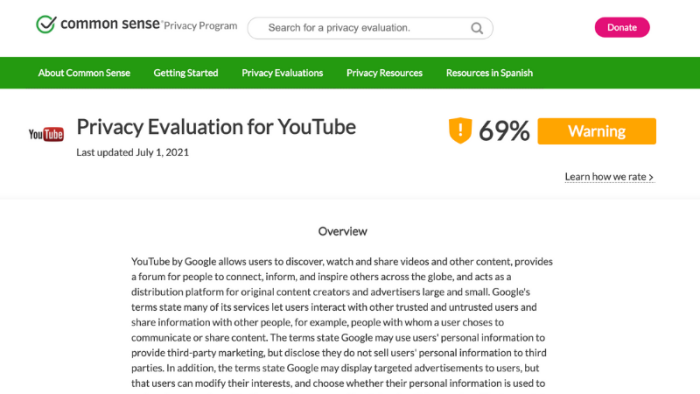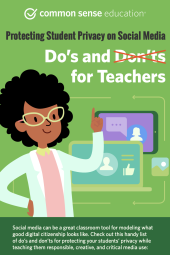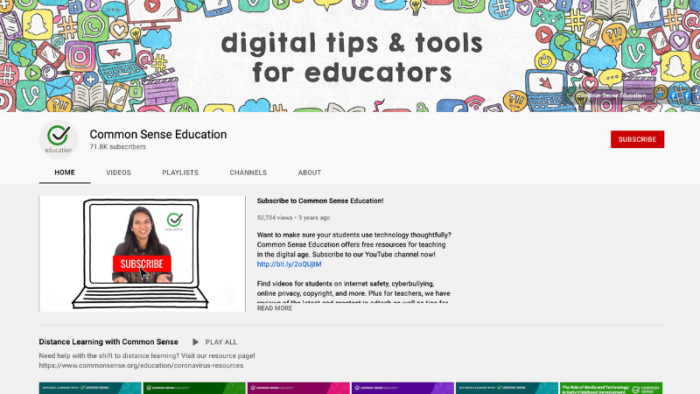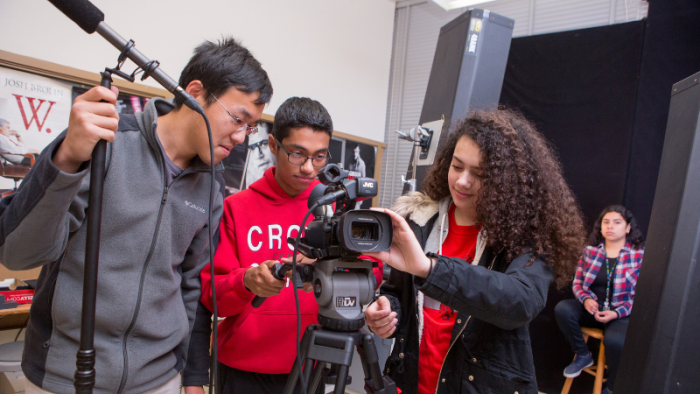Everything you want to know -- and more! -- about using YouTube in your classroom.

With an estimated 500 hours of content uploaded every minute, YouTube’s ever-increasing collection of videos is a lot of things to a lot of people. It's entertainment, it's news and commentary, it's how-to videos, and it's much, much more. But how useful is YouTube for teachers and students?
The reality is that millions of teachers and students around the globe use YouTube for learning every day -- YouTube may very well be the world's most popular destination for online learning. But when it comes to classroom learning, your success with YouTube will depend a lot on how you use it.
Read on to find our answers to teachers’ commonly asked questions about the platform. In addition, we'll share some information on how to find the best educational videos, as well as how you and your students can create and share your own video content on the platform.
Use these links to jump to any section below:
- Is YouTube good for learning?
- What ages or grade levels is YouTube appropriate for?
- What are the privacy concerns when using YouTube in school?
- What is the difference between YouTube and YouTube Kids?
- Where can you find good YouTube videos for learning?
- Does Common Sense Education have its own YouTube channel?
- Are some YouTube videos inappropriate for school?
- Is YouTube a social network?
- What are some creative ways teachers and students can use YouTube in the classroom?
- Can teachers and students use YouTube to create their own videos?
- Are there teacher "influencers" on YouTube?
- How can you use YouTube to teach media literacy?
Is YouTube good for learning?
While videos can never really replace the magic teachers create in their classrooms, they can be a great supplemental resource for instruction. And there are many possibilities for how you can use YouTube in your classroom.
Many of us -- students and teachers alike -- use YouTube for entertainment, but the platform is also a popular destination for general learning content. Whether it's how-to videos, DIY fixes, software tutorials, or arts and crafts instruction, video, as a medium, is naturally useful in showing or explaining new concepts or ideas. This extends to learning content across all topics and for audiences of every age. Want to find an experiment on how to make an electromagnet with a AA battery, copper wire, and a nail? It's there. Or how about a strategy for leading inquiry-based discussions in the classroom? Check. You name it, the list goes on and on ... and on.
While a lot of YouTube videos still come from individual creators, or have more of a homespun feel, there are a host of long-established learning content creators -- like Khan Academy or Crash Course -- who got their starts on the platform. And many well-known media outlets now post content to YouTube as well, with educational video channels offered from the likes of Ted-Ed, Vox, Houghton Mifflin Harcourt, PBS Kids, just to name a few.
With so much educational video content in one place, the main challenge for teachers is to figure out how to find the best content. Keep scrolling to see our tips on finding great videos for learning.

Teachers' Essential Guide to Showing Movies and Videos in the Classroom
Support students' learning, and find the best video streaming sites for schools and classrooms.
What ages or grade levels is YouTube appropriate for?
Legally speaking, YouTube is for users 13 and older, as dictated by the Children's Online Privacy and Protection Act, or COPPA. That said, YouTube's terms or service state that users younger than 13 may use the platform with the permission of a parent or legal guardian. Of course, there are many, many videos on YouTube aimed at younger kids -- at the same time, not everything on the platform is necessarily appropriate for anyone who's at least 13.
For teachers, how you and your students use YouTube in the classroom is very important. YouTube has useful videos for students of all ages, but keep in mind that there's a big difference between a teacher showing a YouTube video to their class and asking students to access and use YouTube with their own device or account. This goes for students' data privacy, but it's also just a good consideration in terms of what's developmentally appropriate for students of different ages. For kids who are under 13, the YouTube Kids app is another option which we'll discuss below.
What are the privacy concerns when using YouTube in school?

Like many digital platforms, YouTube collects data from users in order to tailor content and ads and post suggested videos. It can also collect data from kids who are using the service. For a more detailed look, you can check out Common Sense's privacy evaluations of both YouTube and YouTube Kids.
As with any digital tool or website, teachers should be aware of the digital privacy implications for using the tool with students in the classroom. As we've already stated, how you and your students use YouTube in the classroom is very important -- there's a big difference between a teacher projecting a relevant or useful YouTube video for their class, and asking students to access and use YouTube on their own, especially for students who are under 13 years old.

Also, if you or your students are creating and posting content to YouTube, it's important to be aware about protecting students' personally identifiable information online.
For tips on keeping students' information confidential online, check out our article: Protecting Student Privacy on Social Meida: Do's and Don'ts for Teachers. We also have this handy infographic that sumarizes the article's tips in a handy poster you can hang in your classroom.
What is the difference between YouTube and YouTube Kids?
YouTube Kids is a free app created by YouTube designed specifically for children under 13 years old to browse and watch videos on their own. Every video in YouTube Kids is pulled from the main YouTube database, and also exists on the main YouTube platform. The difference is that YouTube Kids offers parents and families a safer, "walled garden" type of experience.
Theoretically, kids can discover and watch a large selection of kid-focused and kid-appropriate videos without also encountering the types of non kid-appropriate content you'd find on the main YouTube platform. YouTube Kids curates its kid-friendly videos through a combination of automated filters and human review -- but there have been instances where problematic content has slipped through the screening processes. Not to mention larger questions about whether the platform's videos can be considered educational or enriching on their own. As with the main YouTube platform, some degree of adult oversight is still important with YouTube Kids.
The app features tools to help parents and families further filter content by age and subject. You can also disable the search feature and limit kids' screen time using a timer. Keep in mind that YouTube Kids wasn't designed for the classroom, but it's possible that teachers may find some creative ways to use it for learning.
Where can you find good YouTube videos for learning?
To find quality learning videos on YouTube, it's helpful to know where -- but also how -- to look for them. A lot of this will depend on the topic you're teaching, as some topics might simply have more videos than others. A simple search for any given subject or topic could potentially give you hundreds -- if not thousands -- of results. Say you're an English teacher looking for a supplemental video with examples of figurative language -- the results are overwhelming.
Looking to refine your search results? Here are a few YouTube search tips to help you find the best educational videos for your class:
- Try substituting different keywords in your search to elevate different videos to the top of the list.
- Use YouTube's more advanced search filters to narrow your results (look for the "filter" button at the top of your results). There are lots of filter options, including upload date, video type, duration, and even number of views.
- Look for channels from trusted sources and well-known educational content providers, then search within those channels.
Does Common Sense Education have its own YouTube channel?

Yes! The Common Sense Education YouTube channel is chock full of great videos for both students and teachers. From digital citizenship videos for students to content just for teachers like tool reviews and live PD webinars, the channel has a lot to offer. While you're there, be sure to subscribe to get updates any time a new video is posted.
Are some YouTube videos inappropriate for school?
Unfortunately, yes -- many of the videos on YouTube are not appropriate for classroom use. On the flip side, there are also plenty of other videos that are great for classrooms -- it's just a matter of finding them (for more on this, see our tips above). Like many other sites with user-generated content, YouTube employs both human moderators and automated systems to comb through content that might break its community guidelines -- things like spam, nudity or sexual content, hate speech, violence, and more. However, keep in mind that many online platforms -- including YouTube -- rely heavily on automated moderation, which can sometimes mean that inappropriate videos slip through the cracks.
Just like with other online resources, there's only one way for teachers to ensure that content will be appropriate for any given lesson or activity: Always screen everything ahead of time, before class. And keep in mind that if you send your students to the platform on their own, inappropriate content may only be a click away. Also, be aware of YouTube's recommendation features which might display suggested videos -- some of which may or may not be appropriate -- next to, or immediately after, a video you're showing.
Is YouTube a social network?
The best answer is ... sort of. YouTube isn’t a social media platform in the way you might think of Facebook, Instagram, or even TikTok. At the end of the day, for most people, YouTube is mainly a place to find and watch videos. But it's also a place for creators to generate a following of subscribers, for viewers to follow the video creators they like, and even interact with creators through "likes" and comments on videos.
Instead of a social network, it's more useful to think of YouTube as something else -- a search engine. Believe it or not, YouTube is the world's second most popular search engine behind Google (of which YouTube is a subsidiary). The bottom line: YouTube is the go-to place to find and watch videos on the internet, whether you're engaging socially or not.
For classroom use, consider the following with regard to YouTube's more social media-like features, and how they might impact students' learning:
- YouTube's content creators establish channels that they often want users to follow as "subscribers."
- All videos are open to "likes" and "dislikes" from users.
- Many (though not all) videos are open to comments from users -- these comments are often unmoderated, and are sometimes crude or inappropriate.
- Live chats are often attached to live-streaming videos, but pre-recorded videos tend to make up the bulk of YouTube's fare.
- As a teacher, if you're creating your own videos you'll have some options for how (or if) you'd like to use most of the platform's social features, as well as some privacy and visibility settings that might be useful.
What are some creative ways teachers and students can use YouTube in the classroom?

Most of us use YouTube videos as lesson "hooks," or to review a key concept. But there are lots of other creative and innovative ways to use the platform in your teaching. Here are a few ideas, but that's not to say there aren't others out there! As always, be sure to consider the privacy implications before you ask students use YouTube themselves -- as viewers or creators -- or before you publish any videos featuring students or their schoolwork. See our section on YouTube and privacy below for more information.

Keeping Your Students (and Yourself) Safe on Social Media: A Checklist
See our tips on keeping students' information confidential on social media.
- Create a YouTube channel for your class or school. By creating your own channel, you can invite students to create their own content, such as instructional videos, movie or book reviews, screencasts of their presentations, and more. You could even create a channel that serves as a collective digital portfolio of your class' work and accomplishments for the year.
- Flip your classroom. Advocates of the flipped-classroom model argue that time spent with students should be more interactive and promote higher-level thinking, and that other parts of instruction can happen via video. With this model, teachers might record and post a video for students to their YouTube channel ahead of in-person classroom time. This type of model could also be useful during periods of distance or remote learning, where students could watch your instruction asynchronously, then use shared class time for discussion and questions.
- Curate a playlist for a teaching unit or project. YouTube's playlist feature is a great way to gather, save, and share collections of videos you've found. For any given teaching unit, you could curate a list of relevant or related videos for students to watch. Creating a playlist on YouTube is fairly easy, and you can alter the playlist's visibility and sharing settings as necessary. For a student-centered alternative, consider challenging students to research and create their own playlists!
- Assign a video essay project. Video essays are an emerging genre on YouTube, and they challenge students to create multimodal video presentations in place of a traditional written essay. Relative to many other internet videos, video essays tend to be longer, carefully crafted productions, often making arguments about media and culture. To learn more, you can read Common Sense's article: Why and How to Use YouTube Video Essays in Your Classroom.
Can teachers and students use YouTube to create their own videos?
YouTube is a great place for teachers to post lessons, read-alouds, or any other video that might be useful for students' learning. For information on getting started with your own YouTube channel, be sure check out YouTube's "Getting Started" page which has helpful tutorials and information on everything from building a channel and uploading videos to advice on how to create compelling videos.
For teachers, it'll be useful to understand some of YouTube's video settings, including the option to turn off comments, as well as some key privacy and visibility settings for your videos. Any time you post a video, think about settings that will be most appropriate for your video's goal:
- "Public" is the default setting, and means that your video will be visible to anyone in the world and that it will show up in YouTube's search results.
- "Private" means that you'll need to invite others to view the video. But keep in mind that these users will need to have their own YouTube accounts to see the video, which is not always ideal in terms of accessibility for students, and especially tricky for students who are under 13.
- "Unlisted" means that the video won't show up in YouTube's search results, or on your channel page. However, anyone with the link to the video will be able to view it. Some teachers find this to be a good way to share videos with specific students or classes without making them "public" in the traditional sense.
Are there teacher "influencers" on YouTube?
The answer probably depends on how you define "influencer." But, it's safe to say that a growing handful of enterprising teachers have found a niche in creating popular YouTube "influencer-like" channels and videos for other teachers, or even for students. Some focus on sharing classroom and lesson ideas, others might focus on tips for classroom technology, and others yet cover topics like classroom management along with what one might call "professional learning light."
4th Grade teacher Michelle Emerson's channel, "Pocketful of Primary" has over five hundred thousand followers and focuses on classroom management tips and ideas for building student relationships. Alice Keeler's channel, Teacher Tech focuses on -- you guessed it -- classroom technology, with a nod toward Google's education-focused tools. Fernanda Sandoval's channel, That One Happy Classroom offers a range of videos on topics like teacher confidence or getting back into the groove after vacation breaks, along with some reviews of classroom supplies.
Of course, not all teacher-YouTubers attain such huge followings or could be considered "influencers." Most teachers on YouTube are posting content that's simply useful, even if it hasn't gone viral with thousands upon thousands of views. A quick search on the platform can reveal videos on just about any education topic of interest.
How can you use YouTube to teach media literacy?
It's easy to think of YouTube simply as a colossal repository of videos to be found and watched. But it's important for teachers to also consider the role YouTube plays in young people's daily lives -- both as consumers and as creators.
Social media and content creation play a huge role in how young people communicate and interact with the world. This gives teachers lots of opportunities to help students analyze and think critically about the role of YouTube in our media landscape. There are lots of topics here to explore, and you can approach them from numerous angles. But for anyone interested in exploring YouTube from a media literacy lens, here are two topics of interest to get you started:
Influencer Culture: Many young people follow content creators who've amassed thousands, if not millions, of followers on YouTube. Talk to your students about what it means to be an "influencer" or YouTube star in today's world. This New York Times profile of Emma Chamberlain could provide a good starting point. By the age of 18, Chamberlain had dropped out of school to pursue her new career as a YouTube star. But this newfound fame took a physical and mental toll, as the demands of editing and producing content for an ever-hungry audience piled up. Related digital citizenship lesson plans: Curated Lives and Who's Looking at Your Digital Footprint.
Algorithms and Rabbit Holes: Like many online platforms, YouTube’s algorithm is designed to keep people on the site as long as possible, watching more and more video content. But have your students thought critically about how YouTube's recommendations appear, or how much they influence they may have on our viewing habits? When the algorithm identifies one of our interests, how far should it go toward suggesting other similar videos? How much do YouTube's suggestions bolster our perspectives, or lead us toward seeing the world from a narrow, or even misinformed perspective? Related digital citizenship lesson plans: Challenging Confirmation Bias and Filter Bubble Trouble.
Images courtesy of Allison Shelley/The Verbatim Agency for American Education: Images of Teachers and Students in Action.







